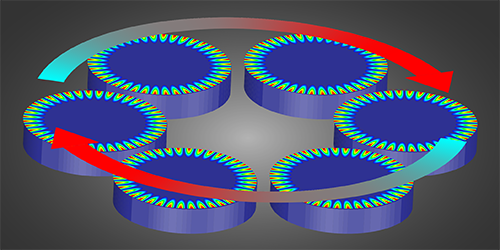Heat Flows in a Circle Without Gradients
Heat flows “downhill” from hot to cold—that’s the normal rule. However, a proposed experiment could generate a continuous heat flow around a ring of resonators all at the same temperature. This flow-without-gradients would consist of heat-carrying phonons that hop from one resonator to the next—like a “phonon carousel”—sustained by a specially engineered optical excitation.
Undriven flows do occur in nature, as evidenced by persistent electric currents in permanent magnets and superconductors. Persistent heat flows have never been observed, but a research team from the University of Paris thinks that could change with arrays of optomechanical resonators, which are small cavity-like objects that support both optical and mechanical modes.
The simplest case considered by the team is a ring of semiconductor disks. Within each disk, energy can switch between optical (whispering gallery) and mechanical (breathing) modes. Optical modes in one disk can also transmit energy to those in neighboring disks. However, gaps between the disks prevent direct coupling of mechanical modes in different disks.
To generate heat flow in such a ring, the Paris group imagine exciting the optical modes using laser light with a properly tailored phase. This engineered light would trigger a wave of excitation that travels in a circle around the ring. The team’s calculations show that quantum fluctuations in the optical excitation create an effective long-range interaction that allows phonons to hop from disk to disk in the direction of the wave. These phonons would carry heat around the ring even in the absence of a temperature gradient. The researchers speculate that such perpetual heat flows could improve the sensitivity of optomechanical resonators used as nanoscale force sensors.
This research is published in Physical Review Letters.
–Michael Schirber
Michael Schirber is a Corresponding Editor for Physics based in Lyon, France.





